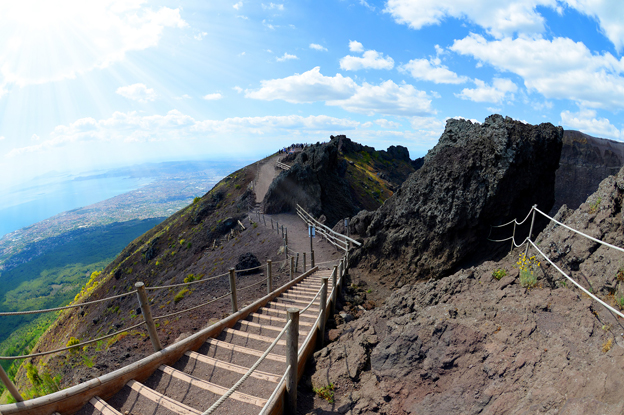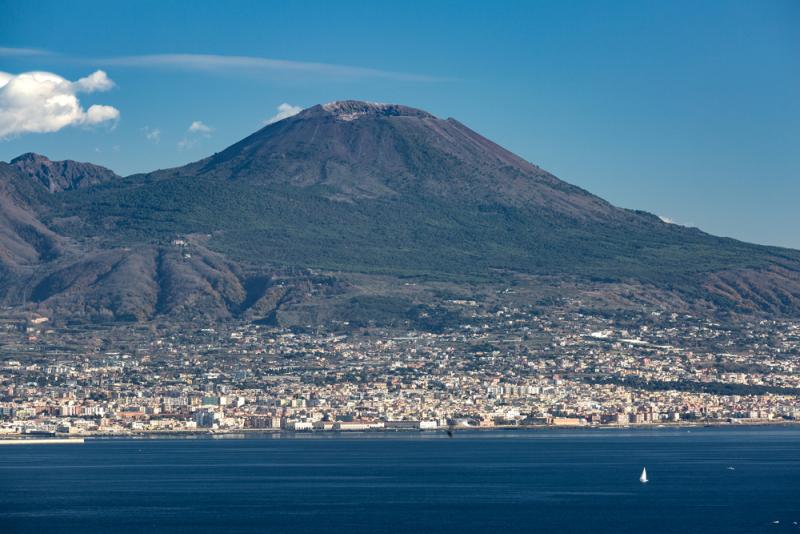Mount Vesuvius, the volcano famous for the 79 AD eruption that destroyed the Roman cities of Pompeii and Herculaneum, today is part of a protected area, the Vesuvius National Park (Parco Nazionale del Vesuvio).
Established in 1995 to safeguard the geological, biological and historical heritage of a territory just 9 km east of Naples, the Park has several hiking trails that give you the opportunity to get close to the crater’s edge, see the lunar landscape of the summit, and enjoy spectacular views of the Gulf of Naples.
A brief history of Mount Vesuvius
Vesuvius has erupted many times since it originated less than 200,000 years ago. It is the only volcano in Europe to have erupted within the last 100 years (the last eruption occurred in 1944).
The geographic position of Mount Vesuvius, the fertile lands rich with minerals contained in the lava, and the beauty of the place have led humans to settle here since ancient times, starting with the Greeks, then followed by the Romans.
The Roman cities of Pompeii, Herculaneum, Stabia and Oplonti were abandoned after the destructive 79 AD eruption, the worst in Vesuvius’ history. At that time, Vesuvius was worshipped as a divinity.

[Photo: Looking toward Mount Vesuvius from a street in Pompeii.]
Between the years 79 and 1037, several eruptions were reported. One occurring in 512 was so severe that people living on the slopes of Vesuvius were made exempt from paying taxes.
Between 1631, year of a major eruption, and 1944, the dwellings on the slopes of the volcano were cautiously built at what was considered a safe distance from the crater. However, after World War II, the demographic growth in the area led to an expansion of the city of Naples toward the east, and that, along with the fact that the volcano has remained silent since 1944, has led to an ever increasing urbanization of the Vesuvian area.
Today, around 3 million people live nearby; it is the most densely populated volcanic region in the world and, for this reason, Vesuvius is regarded as one of the world’s most dangerous volcanos.
Hiking Mount Vesuvius

[Photo: Hiking trail on Vesuvius.]
Vesuvius National Park is centered on the active volcano and its most ancient, now inactive, crater, Monte Somma, which occupies half of the protected area and is the volcano from which Vesuvius originated.
The height of the cone is 1,281 meters (4,203 feet), but it varies considerably after each major eruption. At the summit of the cone is a crater about 305 meters (1,000 feet) deep and 610 meters (2,000 feet) across; it was formed in the eruption of 1944. Between Mount Somma and the cone is the Valle del Gigante (Giant’s Valley).
The park is home to 612 vegetable and 227 wildlife species. There are nine walking itineraries to choose from.
The first two itineraries, “Valley of Hell” and “Along the Cognoli,” are loops starting in Ottaviano and taking place entirely on Monte Somma, with the chance to reach the Vesuvius cone. On these itineraries, you’ll be able to learn about the related history of the two volcanoes and about the extraordinary biodiversity of the Park, immersed among dense forests, lava and lichens, broom trees and great views over the Gulf of Naples.
Itinerary number 3, the Monte Somma crossing, develops for almost 8 km and gives you the chance to explore the volcano’s past and see the lava formed from the last big eruption in 1944. The trail ends on the top of Monte Somma and this itinerary also affords beautiful views of the Gulf of Naples.

[Photo: Tourists walk around the crater of Mount Vesuvius.]
Note down Itinerary number 4 as it is said to offer the most spectacular view in the entire park. Plus, for Disney cartoons fans, this is where the shack of the Magica De Spell character, known around here as ‘Amelia, la fattucchiera che ammalia,’ the bewitching sorceress, is located.
Itinerary number 5 is the most popular, taking you to the Gran Cono of Vesuvius (the large cone that was produced during the eruption of 79 AD). It’s approximately four kilometers long.
The four remaining trails are relatively short, each with a different focus; number 7 takes you through the area where the famous pomodorini a piennolo (cherry tomatoes), typical of the area, are produced.
For more information, visit the website of the National Park of Vesuvius.













